Flowers for the garden, blooming all summer

To create a beautiful flower bed or decorate a plot, each gardener selects plants in his flower garden that are not only beautiful, but also have long flowering. Such flowers can delight all summer and require a minimum of effort. Perennial flowers are especially handy. They can be planted for more than one year. It is only worth keeping in shape and taking preventive measures on time. Annuals are distinguished by long flowering, but require sowing every year.


Which ones can you plant?
We offer an overview of all summer blooming plants, and the first on the list will, of course, be a rose.
- One of the flowers with long flowering is considered a rose. - a symbol of sophistication and beauty. The main varieties are branched shrubs reaching 1.7 meters in height. There are many varieties of this culture.
Bush varieties They are distinguished by a large, sprawling shape, reaching a diameter and height of 1.5 meters. The flowers are not very large, about 4 cm, located in large clusters. Border types of a flower are short, up to 80 cm, and small flowers, 3 cm in diameter, collected in small inflorescences. A climbing rose can reach a height of 3-4 meters. The highly branched crown is covered with thorns and requires support and a garter. Flowers are large, numerous, collected in inflorescences. A groundcover rose spreads on the ground with its shoots to a diameter of 2-3 meters.
All of these varieties begin to bloom in early summer and continue to bloom until late autumn.



- Different types of daisies will fit perfectly into the landscape design of any suburban area or flower beds. They come in a variety of shades: white, pink, yellow. The plant is quite easy to care for. Chamomile for mass planting for the garden is the most beautiful. The plant grows to a height of 30 cm. It has the shape of a bush, from which a flower blooms on thin stems.
Many blooming daisies are arranged in a bouquet on their shoots. Flowering continues throughout the summer season.


- Petunia - an irreplaceable flower for a summer residence or any flower bed. The annual is distinguished by funnel-shaped flowers of different colors. They are long-flowering, emit a lot of seeds and reproduce by self-sowing. The plant takes root well in any conditions. Grows well, braiding free space. It begins to bloom from early spring to late autumn.
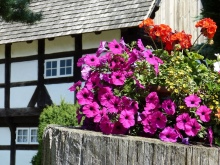


- Clematis - climbing, perennial, ornamental plant, which, thanks to its antennae, clings to any support. It belongs to the buttercup family. Flowers of various shapes, may be in inflorescences or have an independent position - it all depends on the species. Clematis is a long-flowering plant that blooms throughout the summer. The shades of flowers are very different, depending on the soil, climate, illumination.



- Yucca. This flower is a branched shrub of long green leaves. They are lanceolate with a sharp end, collected in a bunch at the base. Flowering is a high, up to 1 meter, strong stem, at the top of which there is a paniculate inflorescence, consisting of large white bells. The flower lasts about a month, exudes a wonderful aroma. After flowering, it is cut off, leaving the shrub itself from the leaves, which retain their greenery until the very frost, thereby decorating the site.
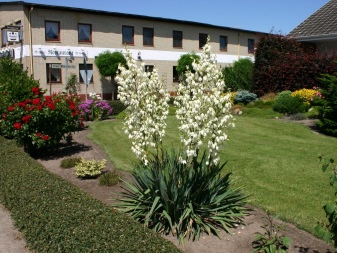
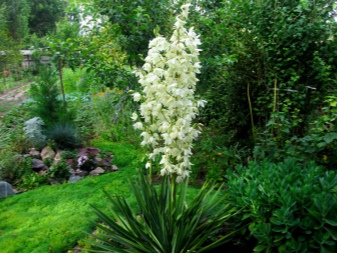
- Delphinium - a tall perennial that is popular with most gardeners due to its long flowering.It is also called a spur, as there are spur-like outgrowths at the base of the flowers. The plant builds inflorescences on straight, elongated racemes more than half a meter high. The flowers are colored cyan, blue, or magenta. Blooming all summer, they differ only in the beginning of flowering. Many begin to bloom in early spring, others in mid-summer. There are high and low varieties of this plant. The tall ones reach 2 meters, the dwarf ones - 30 cm. The height of the flower depends on the fertility of the soil. Delphinium prefers a place of growth in the sun.


- Rudbeckia - ideal flowers for growing in the country. Its perennial species do not require transplantation, therefore they grow in one place for several years. The structure of the rudbeckia inflorescence is similar to a chamomile with a yellow or orange tint. Easily propagated by dividing the bush or by seeds. Grows in the sun, likes regular watering. Flowering is long, begins in early summer and continues until the very frost. The flower grows beautifully, forms a sea of bright, sunny flowers.

- Lush sage - the plant grows up to 40-50 cm. It differs in a dark lilac shade of flowers, which are collected in spike-shaped inflorescences. The bloom begins in June and lasts until August. The advantages of this flower are not only the duration of flowering, but also the presence of healing qualities, a fragrant, persistent aroma. Sage loves to grow in full sun with moderate watering.
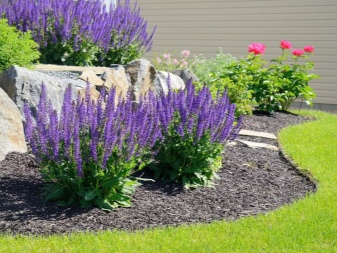

How to arrange on a flower bed?
If you have a flower bed in front of the house, place the flowers in the order of planting in height. Low-growing plants, such as petunia, will help you to emphasize the border. You can land it with a solid line. Plant a delphinium behind it, it will be higher, it will not close the low stands in front.
If your bed is close to a fence, plant the tallest plants in the background. Clematis and a climbing rose work well for this.
They will braid the fence, will not interfere with the growing plantations in front. Your flower bed will look great all summer thanks to the long blooming of these plants.


Care rules
So, a variety of flowers are planted on the site, which require individual care. But there are uniform rules for keeping numerous landings.
- Do not plant different varieties of flowers tightly to each other. There should not be too little space between the plants.
- Remove weeds and loosen the soil in time.
- In strongly overgrown flower beds, there is poor ventilation, and moisture stagnation begins. This promotes the development of parasites and fungal infections.
- Fertilize the plantings with organic fertilizing, add wood ash, humus from the leaves. Perform preventive spraying with any insecticide twice a year.
- Remove faded buds immediately after flowering.



Beautiful examples in landscape design
Thanks to the large assortment of colors, you can create individual landscape design compositions. If you have a gazebo or a fence made of mesh or wooden picket fence on your garden plot, you can plant clematis and a climbing rose along them. They will grow beautifully and braid your fences and structures, making them decorative and distinctive.


A vertical flower bed can be installed on the lawn area. A petunia planting is perfect for this.

Lush sage can be planted along the path to the house. This composition will highlight the pavement and add a mild, pleasant scent.

Roses will go well with rudbeckia in a round flowerbed in the middle of the lawn area. Rudbeckia can be planted in a circle of a flower bed, it will visually highlight it, and place roses in the center.

If you install metal arches on the site and plant clematis near them, then over time they will braid the structure completely, and there will be an incredibly beautiful structure.
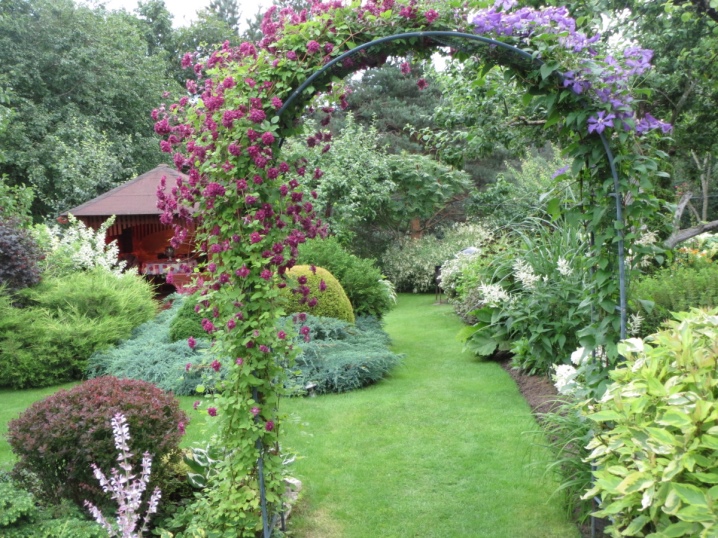
For unpretentious perennials blooming all summer, see below.







































































































The comment was sent successfully.